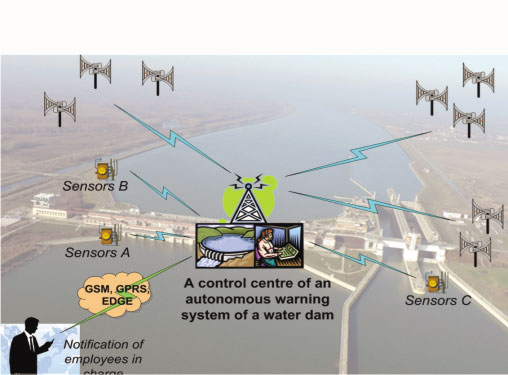Warning systems designed for water dams
Typical hazards
Dams have been built by people for centuries. Yet, despite extensive experience and technological progress, there is still a risk, given by natural disasters or by human activities (military or terrorist attacks), of dam mechanical damages and of endangering people living in the area around dams. In these cases early warning can help, especially, in term of saving people’s lives. Depending on local legislation, warning systems are either established by state, municipality or by dam operator.

Solution Description
This solution is designed as an integrated monitoring, warning and notification system. When preparing this solution its reliability and false alarm elimination were of main concern. The reliability of this solution is ensured both by siren reliability and its auto-testing functionality and by quality of the monitoring system. This system was designed so that it would eliminate as many false alarms as possible and signal any damage of a dam sufficiently in advance. There is only one control centre and its technology is fully backed up. Communication in the system is of radio-type and since it mainly involves small and medium-sized systems (usually 5 - 30 sirens), there is no need for autonomous communication infrastructure in most of the cases. The radio modems installed directly in sirens, which can also be used as signal boosters if required, are sufficient when considering the desired response time. In the case of extensively divided terrain autonomous signal boosters can be used. The system consists of:
- a fully backed up dispatching centre;
- PAVIAN-type electronic sirens;
- Communication infrastructure fully integrated with sirens;
- Monitoring system and transmitters;
The system is connected to a national or local warning system via sirens and via VEKTRA dispatching software and its configuration can very well consider a) local conditions of a particular dam and b) national legislation.
Control centre
A dispatching centre mainly performs the following tasks:
- It continuously monitors the status/functionality of the entire system;
- It monitors conditions of a dam via transmitters connected to a mainframe;
- When exceeded limit values are detected by transmitter, operators are notified - locally or, in the case of unmanned workplaces, by phone;
- When exceeded limit values are detected by at least two transmitters, the system initiates notification process and, at the same time, it activates a count down set up pursuant to the national legislation (5 minutes in the Slovak Republic), during which the operators can verify the data provided by transmitters and deactivate a pre-warning message;
- If the deactivation process is not performed within the time limit given, a warning message is initiated and so is the notification process, i.e. calling employees in charge and informing relevant institutions on an emergency situation occurrence;
- it is connected to a national warning system or a public-address system;
- It records communication at a dispatching centre for purposes of its future analysis;
It consists of:
- a computer with installed VEKTRA software;
- a central communication unit or siren;
- extra modules designed to notify, record or monitor;
Electronic sirens
To make sure that PAVIAN electronic sirens used as terminal acoustic elements designed to distribute sound in municipalities located around dams, i.e. to warn the population of such municipalities are fully functioning they are equipped with the complete auto-testing functionality and all their modules.
Communication infrastructure
This infrastructure is commonly used to control sirens at a designated radio channel. These sirens are further controlled from a national warning system via RDS. Thus the RDS channel represents a backup control channel. It is, however, possible to use other available communication channels.
Monitoring system
As a rule, a designated radio channel is used as the main communication channel; however, a satellite control channel or standard WiFi communication network can be used to control sirens as well. Radio modems installed in sirens, which typically form their optional parts/modules, are sufficient for communication needs at designated radio frequencies. These modules also offer the possibility of each siren being used as a retransmitting station, thereby remarkably lower the costs of building the radio communication infrastructure. In the case of bigger cities, more developed areas or rugged terrains, independent retransmitting stations or the SMART communication units can be used. The use of WiFi technology requires the establishment of independent communication infrastructure that takes into consideration the limited coverage area of individual transmitters. The use of satellite communication is simple as it means the installation of a specific satellite data modem in each siren delivered by the relevant service provider; nevertheless, the operational costs are still relatively high. A back-up control channel can be selected according to the local conditions and type of the main communication channel, and it should not share any elements of the main communication infrastructure.
Electronic sirens Pavian
A monitoring system provides data for siren activation. It is established independently from the operated monitoring system in order to improve its reliability and to increase the possibility of their crosscheck. Sensors send status information via the same communication infrastructure as sirens but the sensors can also be connected in a different way. Types of sensors are selected based on a dam type and, in order to eliminate false alarms, minimum two different transmitters are used (e.g. leakage and inclination measurement e.g.).
Our Solutions

Technical requirements for mass public warning systems
The early mass warning to the general public against natural disasters, terrorist and military attacks, and other man-made disasters is one of the fundamental responsibilities of every modern state
